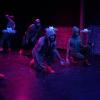
The Black Choreographers Festival: Here and Now is celebrating its 20th anniversary with an impressive roster of events in San Francisco this month. World premieres by established local choreographers and the Next Wave Showcase of works by emerging and mid-career artists continue at Dance Mission Theater for the next two weekends, Feb. 22 – March 2.
The festival started two weeks ago with a site-specific work hosted by San Francisco’s Museum of the African Diaspora. Three dancers interacted with the current exhibit Liberatory Living: Protective Interiors & Radical Black Joy, and a free panel discussion brought together three generations of Black choreographers to discuss what it means to be Black in the Bay Area dance scene and how conditions have hardly changed for Black artists since Halifu Osumare founded Black Choreographers Moving Toward the 21st Century in 1989.

BCF co-founders Kendra Kimbrough Barnes and Laura Elaine Ellis emphasize that their festival is an extension of that pioneering organization. Ellis created the African & African American Performing Arts Coalition in 1995, and Barnes followed in 1996 with K*Star*Productions, both aiming to provide better performance opportunities for Black artists and to produce shows reflecting their experiences.
Ellis offers this quote from Halifu: “When people say, ‘What is Black dance?’ I say, ‘Black dance is what we say it is.’ We take ownership of that narrative,” Ellis continues. “We get to have expression that is vast. It tells many different aspects of Black life and experience, and it is also OK if those experiences that we share resonate with people from other cultures. It’s actually integral to the whole idea.
“I am sixth-generation American and have no connection to where my ancestors came from. But we do have African Americans that are first-, second-, third-generation American, and they do have roots in the [African] continent. The journey we’ve taken through generations is very, very different, and so the stories that we tell through dance absolutely have to be, too.
“Kendra and I decided to expand what genres of dance would be included [in the festival]. You will see rhythm, tap, and traditional dance from the diaspora — in their original and contemporary forms. Contemporary ballet, hip-hop, and voguing.”

Raissa Simpson, artistic director of San Francisco’s PUSH Dance Company, is an award-winning choreographer of African American and Filipino descent. She grew up in the Bay Area and earned degrees from SUNY Purchase Conservatory of Dance and UC Davis.
“[My] piece is honoring [PUSH dancer and choreographer] Rashad Pridgen, who recently passed away,” says Simpson. “It hadn’t really sunk in for me that everybody had a different story about him. I wanted to investigate what it meant to be alive and in a mental and physical state where the small things we do, like walking by somebody, build connections as to who we are but also how we navigate the world around us.

“I decided also to tie that into Black male identity. I’m taking input from my dancers, who are all Black men that come from different age groups, gender identities, backgrounds, and income levels. We also discussed Black male grief. I’ve never seen Black men in my family grieve. We’re asked not to cry or show pain. But yes, we do grieve, and it’s a very difficult and dangerous place. [This work is] a way for me to not just connect with Rashad but to the Black men that I have known and also [to] step back as the choreographer and allow the performers to really generate what I’m asking them to do.”
Meanwhile, choreographer Byb Chanel Bibene is calling attention to migration in his piece. Bibene was born and raised in the Republic of the Congo and lived through two civil wars in his teenage years. He explains the subject of his work for BCF:
This piece is a response to a sad event that’s been happening for the past 10 years. Migrants are crossing the Mediterranean Sea from the African coast to get to European countries like Spain, Italy, Portugal, and all these islands in the middle of the sea. There are thousands and thousands of young Africans who are losing their lives because they’re taking makeshift boats that have been collapsing, and no one will help them. Both African leaders and European ones have the resources to help these people, who are just seeking a better life.
I started working on [this dance] around 2018. I developed ideas, I did research, sometimes I just talked about it. I did presentations about the project and iterations of it as a solo [piece] as it will be here.
I will have some buckets with water elements [to represent how] people are losing their lives under the sea. Water is life and death. The music I chose is [by] Miriam Makeba — it’s South African. And the other soundtrack is [by] an ethnic group from Gabon, which is next to Congo. I love the music, so I chose it because it makes me be in the element.




